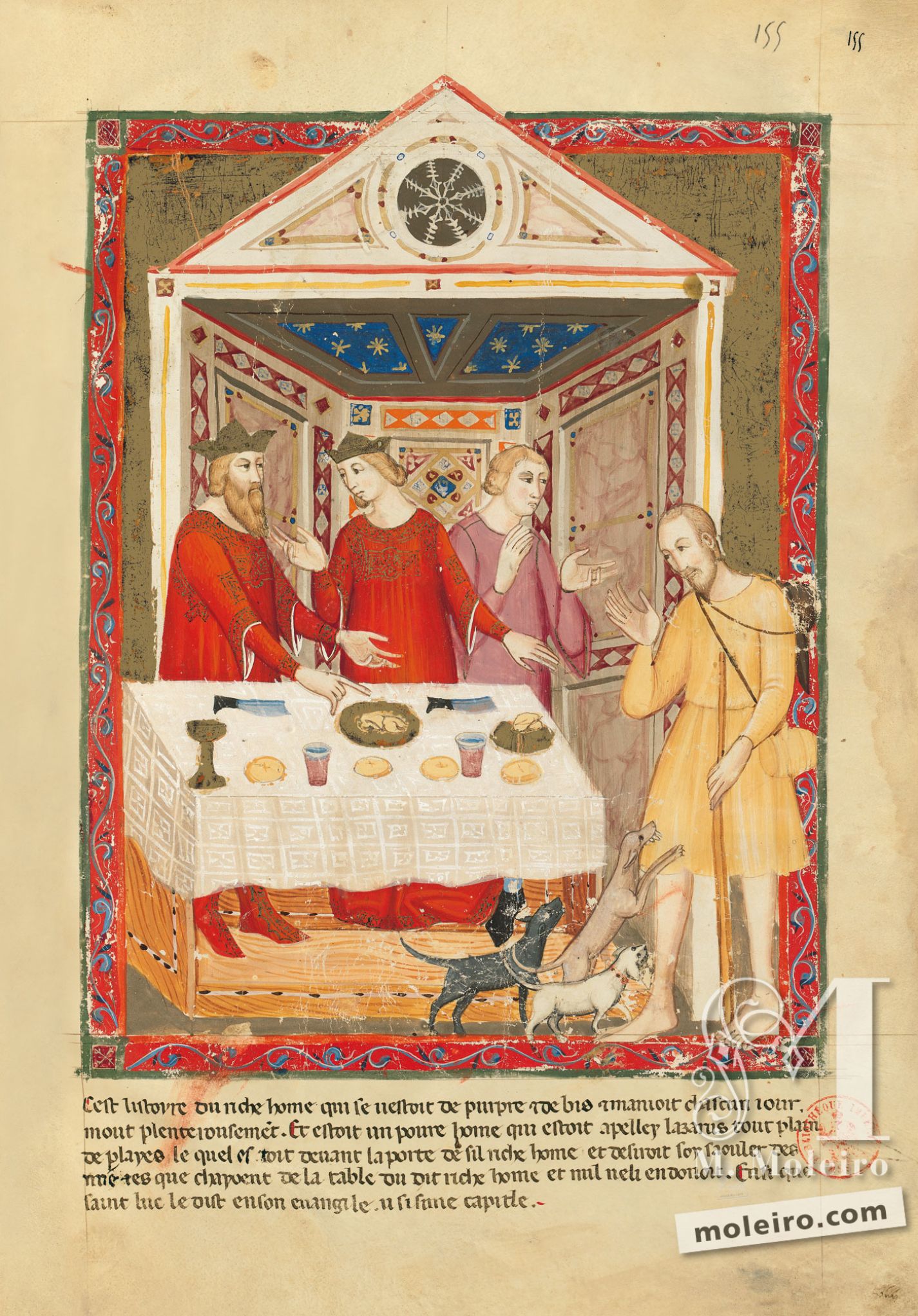“This is the story of the rich man who wore purple and brownish-grey and he ate most plentifully each day. And there was a poor man called Lazarus full of sores who came to the rich man’s door and wanted to take his fill of the crumbs falling from the rich man’s table and no one would give him any. Thus says Saint Luke in his Gospel, in the sixteenth chapter.”
There was once a rich man who wore purple clothes and fine linen and who held splendid feasts every day. A poor man by the name of Lazarus sat patiently on his doorstep hoping to receive crumbs from his table but only the master’s dogs came to him and licked his sores. So begins one of the most famous parables told in the Gospel according to St Luke, depicted by artist A in two successive paintings not forming a diptych in the Bible of Naples.
The dwelling of the rich man is shown like a box open at the front. It is crowned by a triangular pediment and is decorated with coloured marble. Two persons wearing crowns and lavish crimson robes sit together at the table shown as a large, hollow rectangle of wood covered with a white damask tablecloth. The young woman turns to her older husband to intercede for the poor barefoot wretch coming forward. He holds a walking stick, has a small barrel tied to his belt and a peaked hat hanging down his back. He is harried by several dogs, the most vicious of which sinks its teeth into the thigh of the beggar in a short gown, whilst the master of the house points his index finger at a poultry dish and opens his other hand in a vexed, inquiring gesture without giving him anything despite there being food a-plenty as suggested by the four round loaves, two cups of wine, a golden goblet, several knives and two garnished dishes. The rich man in purple next to the woman then seems to pay attention to the beggar, without moving from the bench where he is seated. The rich man Jesus talks about signifies the religious leaders of the Jews who scorn the people and deny them all spiritual nourishment, deeming them to be unworthy to partake of the feast.
Yves Christe
University of Geneva
Marianne Besseyre
Illuminated Manuscripts Research Center, Bibliothèque nationale de France
Fragment of the Bible moralisée of Naples commentary volume

“This is the story of the rich man who wore purple and brownish-grey and he ate most plentifully each day. And there was a poor man called Lazarus full of sores who came to the rich man’s door and wanted to take his fill of the crumbs falling from the rich man’s table and no one would give him any. Thus says Saint Luke in his Gospel, in the sixteenth chapter.”
There was once a rich man who wore purple clothes and fine linen and who held splendid feasts every day. A poor man by the name of Lazarus sat patiently on his doorstep hoping to receive crumbs from his table but only the master’s dogs came to him and licked his sores. So begins one of the most famous parables told in the Gospel according to St Luke, depicted by artist A in two successive paintings not forming a diptych in the Bible of Naples.
The dwelling of the rich man is shown like a box open at the front. It is crowned by a triangular pediment and is decorated with coloured marble. Two persons wearing crowns and lavish crimson robes sit together at the table shown as a large, hollow rectangle of wood covered with a white damask tablecloth. The young woman turns to her older husband to intercede for the poor barefoot wretch coming forward. He holds a walking stick, has a small barrel tied to his belt and a peaked hat hanging down his back. He is harried by several dogs, the most vicious of which sinks its teeth into the thigh of the beggar in a short gown, whilst the master of the house points his index finger at a poultry dish and opens his other hand in a vexed, inquiring gesture without giving him anything despite there being food a-plenty as suggested by the four round loaves, two cups of wine, a golden goblet, several knives and two garnished dishes. The rich man in purple next to the woman then seems to pay attention to the beggar, without moving from the bench where he is seated. The rich man Jesus talks about signifies the religious leaders of the Jews who scorn the people and deny them all spiritual nourishment, deeming them to be unworthy to partake of the feast.
Yves Christe
University of Geneva
Marianne Besseyre
Illuminated Manuscripts Research Center, Bibliothèque nationale de France
Fragment of the Bible moralisée of Naples commentary volume